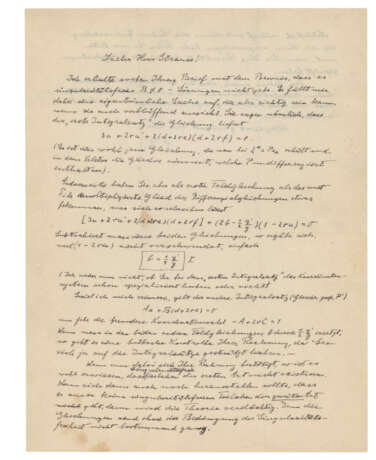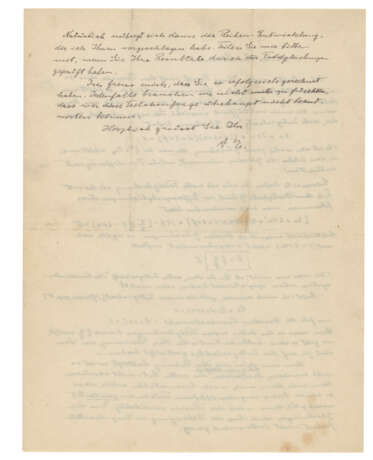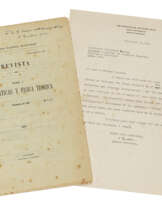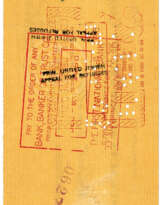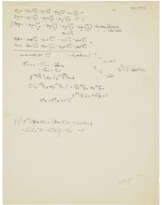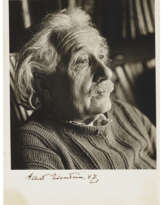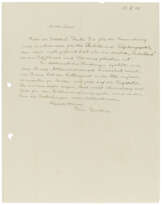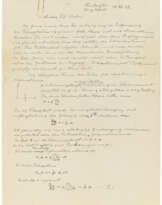ID 794479
Lot 73 | EINSTEIN, Albert (1879-1955)
Estimate value
£ 18 000 – 25 000
Autograph letter signed (with initials, 'A.E.') to Ernst Gabor Straus (here 'Herr Strauss' [sic]), n.p., n.d. [spring/summer 1945].
In German. 1 1⁄4 pages, 281 x 216mm, including seven scientific equations.
'It could be right, even if it seems amazing': the development of the 'Swiss cheese' model of the inhomogeneous universe.
Einstein plunges straight into scientific discussion from the first words of the letter:
'I have just received your letter with the proof that there are no singularity-free solutions B ≠ 0. One thing strikes me as strange, but it could be right, even if it seems amazing. That is, you say that the "first integral theorem" gives the equation
3a + 2ra‘ + 2(d+2re)(d+2rf) = 0
(This is probably the equation one gets with ξ a = Pxa and takes within the vector the terms which contain P undifferentiated).
On the other hand, as the term of the differential equations multiplied by dik in the first field equation you have come up with something that can be written like this
[3a + 2ra‘ + 2(d+re)(d+2rf] + (2b - 1⁄2 .g’/g)(1-2ra) = 0
If one subtracts these two equations, it works out, as (1-2ra) does not disappear, simply as
b = 1⁄4 .g'/g I [Einstein draws a box around this equation to underline its significance]
(Now I don't know whether you have already specialised the coordinate system in the "first integal theorem" or not)'.
Einstein goes on to introduce a 'neat control for your calculation' by replacing the term b with 1⁄2 .g'/g in the other field equations. 'If this now confirms your calculation, it is in fact proved that singularity-free particles of the first kind do not exist. If it should then turn out that there are also no singularity-free particles of the second kind, the theory becomes suspect. For the equations are insufficiently determinant without the condition of freedom from singularity'. In that instance, the series development Einstein had suggested becomes superfluous. He asks Straus to let him know as soon as he has checked his results against the field equations and congratulates him on his successful calculations, concluding 'In any case, we no longer need to worry about not being able to come up with any kind of answer to this particle question'.
The German-American mathematician Ernst Gabor Straus (1922-1983) was Einstein's assistant at Princeton for four years between 1944 and 1948, during which period they produced three joint papers. The present letter perhaps relates to the second of these, 'The Influence of the Expansion of Space on the Gravitation Fields surrounding the Individual Stars' (Reviews of Modern Physics, 17 (April-July 1945), pp.120-124), in which Einstein and Straus proposed the 'Swiss cheese' model of the universe, the first serious attempt to model an inhomogeneous universe. Einstein frequently struggled with the correct spelling of Straus's last name at this period.
Special notice
This lot has been imported from outside of the UK for sale and placed under the Temporary Admission regime. Import VAT is payable at 5% on the hammer price. VAT at 20% will be added to the buyer’s premium but will not be shown separately on our invoice.
| Artist: | Albert Einstein (1879 - 1955) |
|---|---|
| Place of origin: | Switzerland |
| Auction house category: | Letters, documents and manuscripts, Medicine & science |
| Artist: | Albert Einstein (1879 - 1955) |
|---|---|
| Place of origin: | Switzerland |
| Auction house category: | Letters, documents and manuscripts, Medicine & science |
| Address of auction |
CHRISTIE'S 8 King Street, St. James's SW1Y 6QT London United Kingdom | |
|---|---|---|
| Preview |
| |
| Phone | +44 (0)20 7839 9060 | |
| Buyer Premium | see on Website | |
| Conditions of purchase | Conditions of purchase |
